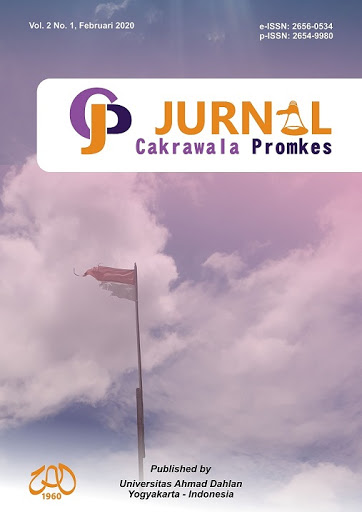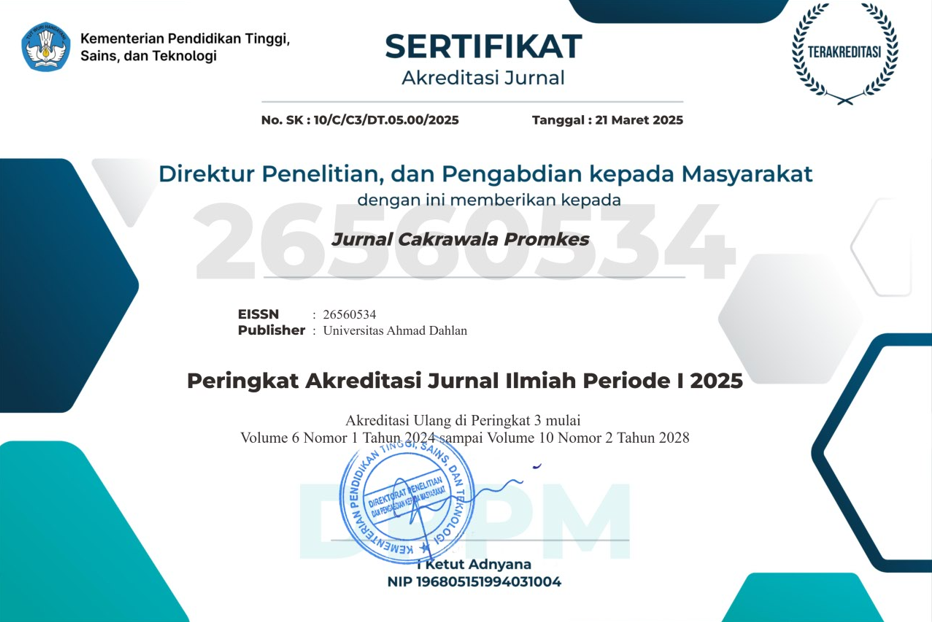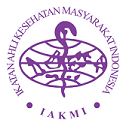Hubungan tingkat pengetahuan tentang gizi, peer group dan uang saku dengan pemilihan jajanan pada siswa SLTP
DOI:
https://doi.org/10.12928/promkes.v3i2.4857Keywords:
Ecological behavioural model, Food security, Nutrition, Snacking behaviorAbstract
Poor nutritional behaviour among students is the increasing of snacking proportion and the consumption unnutritious and unsafe food. The aims of the study was to know the determinants of school children's snack behavior using behavioural ecological model. This was a cross-sectional study design based on ecological models behaviour. The study was conducted at a state junior high school in Sleman Regency, D.I Yogyakarta. The sample was 80 students of 381 students. The data were analyzed by the chi-square test. The result showed that only 52.5% students had selected behaviour in snacking, 50% students had a good level of knowledge about nutrition and food security, 68.8% had a large amount of pocket money, 83.8% had breakfast habit, 70% were highly influenced by peers. There were significant relations between knowledge about nutrition and food security and breakfast habits. There were no significant relations between the amount of pocket money, peers with students' behaviour to the selection of snacks in the State Junior High School in Sleman, Special Region Yogyakarta. It is recommended for schools to strengthen their school health institutions through increasing the role of student cadres and counseling about nutrition and food safety in the provision of healthy canteens. Include content about nutrition and the consequences of consuming unsafe food, placing posters on healthy and unhealthy food in the school canteen. Schools are also advised to provide socialization to parents and students about the importance of having breakfast and bringing lunch from home.References
Rakhman AFT. Hubungan Kebiasaan Melewatkan Sarapan dan Pemilihan Jajanan dengan Kejadian Wasting di Desa Sembung , Kecamatan Wringinanom , Kabupaten Gresik Association between Skipping Breakfast and Selection of Snack Food with Wasting Incident in Sembung Village , Wr. E-journal Univ Airlangga. 2018;237–44.
Wang D, Van Der Horst K, Jacquier EF, Afeiche MC, Eldridge AL. Snacking patterns in children: A comparison between Australia, China, Mexico, and the US. Nutrients [Internet]. 2018;10(2):1–14. Available from: www.mdpi.com/journal/nutrients
Infodatin: Bawa Bekal Nasional [Internet]. 2020. Available from: https://pusdatin.kemkes.go.id/article/view/20111200001/hari-bawa-bekal-nasional.html
Manalu HSP, Suudi A. Kajian Implementasi Pembinaan Pangan Jajanan Anak Sekolah (PJAS) untuk Meningkatkan Keamanan Pangan: Peran Dinas Pendidikan dan Dinas Kesehatan Kota. Media Penelit dan Pengemb Kesehat [Internet]. 2017;26(4):249–56. Available from: http://ejournal.litbang.depkes.go.id/index.php/MPK/article/view/5734/4650
Mirkarimi K, Mansourian M, Kabir MJ, Ozouni- RB. Fast food consumption behaviors in high-school students based on the theory of planned behavior (TPB). Intrenational J Pediatr. 2016;4(7):2131–42.
Kementerian Kesehatan RI. Situasi pangan jajanan anak sekolah. In 2014.
Mithra P, Unnikrishnan B, Thapar R, Kumar N, Hegde S, Mangaldas Kamat A, et al. Snacking Behaviour and Its Determinants among College-Going Students in Coastal South India. J Nutr Metab. 2018;1–6.
Sunarti E, Islamia I, Rochimah N, Ulfa M. Pengaruh faktor ekologi terhadap resiliensi remaja. 2017;10(2):107–19.
Glanz K, Rimer BK, Viswanath K. Health Behavior and Health Education [Internet]. 4th ed. Glanz K, Rimer BK, K. Viswanath, editors. Jossey Bass A Willey Brand; 2008. 4 p. Available from: http://140.112.36.179:8080/uploads/bulletin_file/file/568a39ae9ff546da4e02eb72/Health_behavior_and_health_education.pdf#page=227
Sogari G, Velez-Argumedo C, Gómez MI, Mora C. College Students and Eating Habits: A Study Using An Ecological Model for Healthy Behavior. Nutrients [Internet]. 2018;10(12):1–16. Available from: http://www.ncbi.nlm.nih.gov/pubmed/30477101%0Ahttp://www.pubmedcentral.nih.gov/articlerender.fcgi?artid=PMC6315356
Dinas Kesehatan Kabupaten Sleman. Profil Kesehatan Kabupaten Sleman. 2018. 1–80 p.
Notoatmojo S. Promosi Kesehatan Teori dan Aplikasi. Jakarta: Rhineka Cipta; 2012.
Hatta H, J. Hadi A, Yetti R E, Tombeg Z, Manggabarani S. Hubungan Faktor Pemilihan Makanan Jajanan Siswa di Sekolah Dasar Inpres Maccini Sombala Kota Makassar. J Kesehat. 2018;1(4):355–63.
Handayani S, Hartono. Hubungan Pengetahuan Guru Dan Pengelola Kantin Tentang Gizi Btp (Bahan Tambahan Pangan) Terhadap Penggunaan Btp Beresiko Pada Makanan Anak Sd Di Surakarta. J Terpadu Ilmu Kesehat. 2016;5(2):110–237.
Permatasari P, Sharadea. Strategi Promosi Kesehatan Terhadap Upaya Peningkatan Pengetahuan Pengelola Kantin Sehat. J Media Publ Promosi Kesehat Indones. 2018;1(3):69–74.
Afolaranmi T, Hassan Z, Bello D, Misari Z. Knowledge and practice of food safety and hygiene among food vendors in primary schools in Jos, Plateau State, North Central Nigeria. E3 J Med Res. 2015;4(2):16–22.
Widajanti L, Suryawati C, Sugihantono A. Pengaruh Komik Makanan Jajanan Sehat dan Bergizi untuk Meningkatkan Pengetahuan dan Sikap Anak Sekolah Dasar. Indones J Public Heal. 2009;6(1):19–23.
Rahayu S. Related Factors With Selection of Students Food in Gentan Elementary. J Pendidik Tek Boga. 2018;6(7):1–9.
Alamin RL, Syamsianah A, Mufnaetty. Hubungan Sarapan Pagi di Rumah dan Jumlah Uang Saku Dengan Konsumsi Makanan Jajanan di Sekolah Pada Siswa SD N Sukorejo 02 Semarang. J Gizi Univ Muhammadiyah Semarang. 2014;3(1):40–50.
Desi, Suaebah, Astuti WD. Hubungan Sarapan, uang saku dengan Jajanan di SD Kristen Immanuel II Kubu Raya. J Vokasi Kesehat. 2018;(7):48–53.
Batis C, Rodríguez-Ramírez S, Ariza AC, Rivera JA. Intakes of Energy and Discretionary Food in Mexico Are Associated with the Context of Eating: Mealtime, Activity, and Place. J Nutr. 2016;146(9):1907S-1915S.
Neumark-Sztainer D, French SA, Hannan PJ, Story M, Fulkerson JA. School lunch and snacking patterns among high school students: Associations with school food environment and policies. Int J Behav Nutr Phys Act. 2005;2(14):1–7.
Arisdanni, Buanasita AN. Hubungan Peran Teman , Peran Orang Tua , Besaran Uang Saku dan Persepsi Terhadap Jajanan Dengan Kejadian Gizi Lebih Pada Anak Sekolah. Amerta Nutr. 2018;189–196.
Downloads
Published
Issue
Section
License
Copyright (c) 2021 Intan Wahyuni Tukiyo

This work is licensed under a Creative Commons Attribution-ShareAlike 4.0 International License.
Authors who publish with JCP: Jurnal Cakrawala Promkes agree to the following terms:
- Authors retain copyright and grant the journal the right of first publication with the work simultaneously licensed under a Creative Commons Attribution License (CC BY-SA 4.0) that allows others to share the work with an acknowledgement of the work's authorship and initial publication in this journal.
- Authors are able to enter into separate, additional contractual arrangements for the non-exclusive distribution of the journal's published version of the work (e.g., post it to an institutional repository or publish it in a book), with an acknowledgement of its initial publication in this journal.
- Authors are permitted and encouraged to post their work online (e.g., in institutional repositories or on their website) prior to and during the submission process, as it can lead to productive exchanges, as well as earlier and greater citation of published work.

This work is licensed under a Creative Commons Attribution-ShareAlike 4.0 International License












